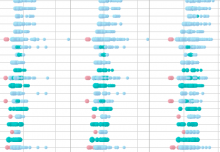As your business has grown, you have made changes to your procedures and systems in order to scale your capabilities to keep up with the demand of your clients. From point of sale systems and phones to your storefront and branding, every aspect of your business should be scaled and leveraged in such a way to support your future success.
Data warehousing and storage, and the use an analysis of that data has become more important than ever before. Even basic data sets, such as customer and transaction information, contain important insights given adequate visualizations, however many business owners aren’t sure when their data collections officially cross the line from ‘data,’ to ‘big data’.
One Size Doesn’t Fit All With Data Analysis
Unlike many business metrics that have clear cut definitions, the collection, organization, and utilization of information can require vastly different resources from one company to the next. It can be difficult to define “big data” concepts using traditional methods given the lack of correlation between the number of employees, revenue, and the volume and complexity of information a business acquires. A company’s ability to handle large or complex data sets will also affect their perception of “big” data.
Leveraging Your Data
So when do you define your data as “big data”? It may not matter! The important part of a business intelligence solution has less to do with how many database servers you are using or how many gigabytes your data consumes, and more to do with how you leverage that data. Many professionals prefer to think of big data as any information set that requires dedicated resources to store and parse beyond a single database or file set.
Relational databases that are growing over time are the most likely candidate, such as a list of customers and transactions. By most accounts, if you are no longer able to summarize your data in a single pie chart, you might just have “big data”!
Business intelligence isn’t just about gathering enormous quantities of data, though this does happen; it is about using existing data to recognize trends and patterns, and using these statistical points to make decisions. Even if your business is accumulating data slowly, you may benefit from treating your information like big data. Choosing a data visualization tool that is scalable – like your data – gives you the ability to analyze small information pools now, and grow into ever more complex systems later.
Treat All Data Like Big Data
Rather than waiting for some definitive moment when your databases are bursting at the seams or your bar charts look like a print test page, treat all data as if it were big. Except in the rare event you are avoiding any kind of growth, your business can only benefit by using tools that scale with you as your authority expands.
If you have data, you owe it to yourself and your business to utilize that data properly. Find software that can scale with you, and show you the bottom line quickly and easily, in ways that you, your clients, and your partners can understand. So how much data does it take to be big data? Big data is any data that can make a big impact on your business!



